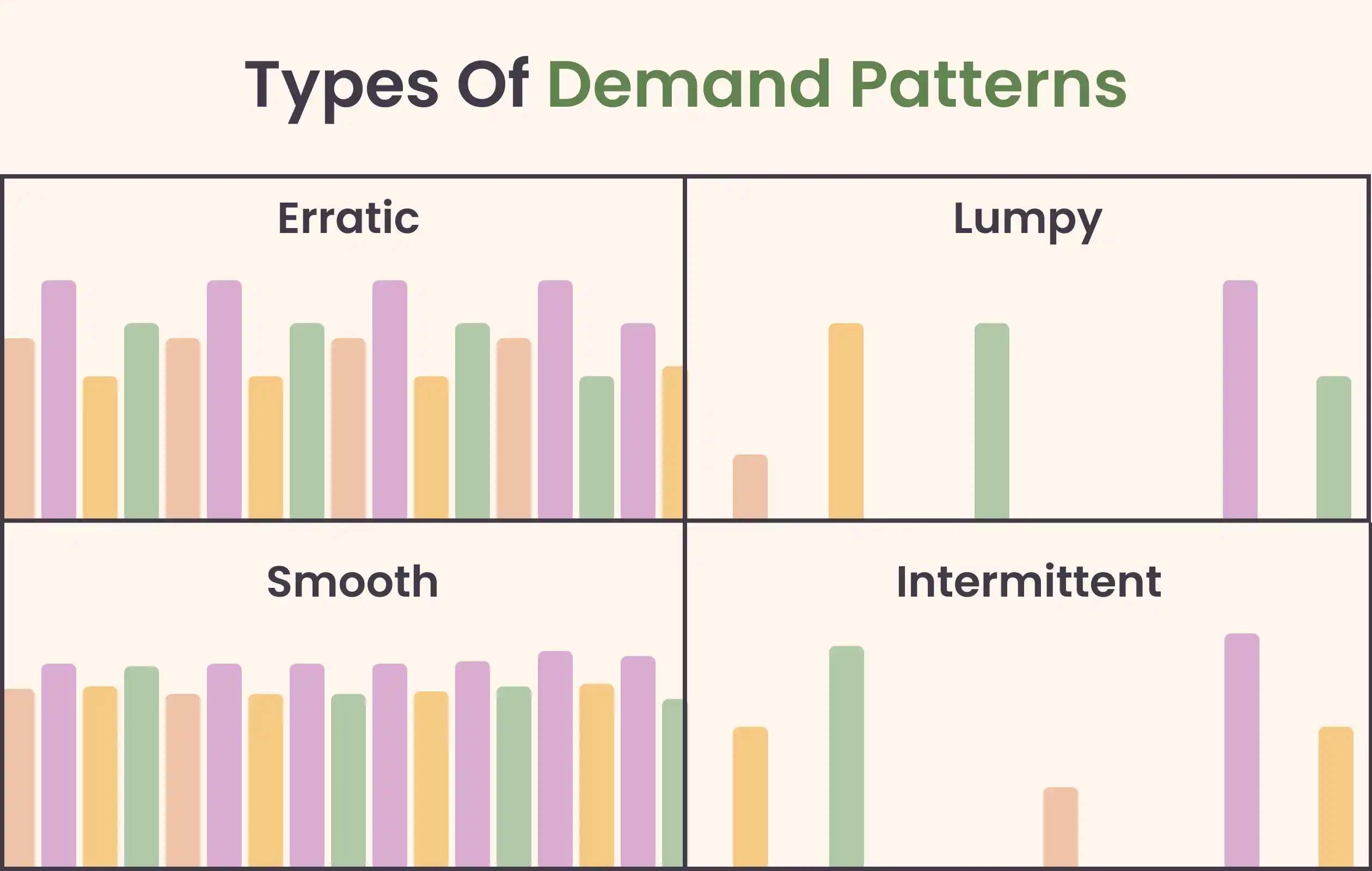Exploring Demand Patterns and their Types

Introduction
Imagine your heart beating and the lines on the monitor are constantly fluctuating. What if now each spike or the dip of your heart shows how the market might function? Demand patterns are the heartbeat of the market that decides how the flow for any product or service might come. Forecasting patterns of demand allow businesses with better supply chain management, which in turn provides businesses with 15% lower costs.
Businesses that have started recently need to take note of the pattern of demands prevailing in the market. This allows the brands to keep a check on the performance of their competitors. Every pattern formed through the demands of a product or service can help businesses decide how the market might perform.
Understanding patterns of demand makes it easier for business owners to understand aspects such as handling their inventories and pricing strategies during unpredictable days. One can consider the pattern of demand as a secret code of businesses to unlock the key to success.
Companies can form more alignment with patterns of demand by keeping a check on factors like new product introduction (NPI), seasonal changes, or promotional events.
With several types of demands in the market, it is necessary to understand their types. Each demand type works in a different way to address a unique customer behavior.
Types of Demand Patterns

Anticipating how a consumer might act towards a product or service is crucial for businesses. These anticipations help in analyzing several factors such as inventory management and budgeting for one’s production or service.
Some of such patterns that play a major role in the betterment of business are:
1. Smooth Demand Pattern
2. Lumpy Demand Pattern
3. Intermittent Demand Pattern
4. Erratic Demand Pattern
1. Smooth Demand Pattern
A smooth demand pattern is characterized by a steady and predictable demand for a product or service over time. This type of demand pattern is often associated with products or services that are in constant demand, such as essential goods like groceries, utilities, or other commodities. For example, people will always need to buy groceries to sustain themselves, so the demand for groceries tends to remain stable over time.
Businesses that experience a smooth demand pattern can plan their operations accordingly, making long-term decisions based on the assumption that demand will remain stable. They can maintain a steady level of production, inventory, and staffing without worrying about sudden fluctuations in demand.
However, businesses must also be aware of external factors that can disrupt the smooth demand pattern, such as changes in the economy or the emergence of new competitors. These factors can cause demand to shift and require businesses to adjust their operations accordingly.
2. Lumpy Demand Pattern
A lumpy demand pattern is characterized by sporadic demand that occurs in irregular intervals. This type of demand pattern is often associated with products or services that are purchased infrequently or in bulk, such as furniture, appliances, or construction materials. For example, people may only purchase a new refrigerator every 10 years or so, which creates a lumpy demand pattern for refrigerators.
Businesses that experience a lumpy demand pattern must plan their operations around the peaks and valleys of demand. They may need to ramp up production and staffing during peak demand periods and then scale back during low demand periods. This can be challenging, as it requires businesses to be nimble and adaptable to sudden changes in demand.
One strategy that businesses can use to manage lumpy demand patterns is to implement a just-in-time (JIT) inventory system. This system involves keeping inventory levels low and ordering products only when demand requires it. This can help businesses save on storage costs and reduce the risk of overstocking.
3. Intermittent Demand Pattern
An intermittent demand pattern is characterized by demand that occurs irregularly, with long periods of low demand followed by sudden spikes in demand. This type of demand pattern is often associated with products or services that are seasonal, such as winter clothing, holiday gifts, or vacation rentals. For example, demand for holiday gifts tends to be low throughout most of the year, but spikes dramatically in the weeks leading up to Christmas.
Businesses that experience an intermittent demand pattern must plan their operations around the seasonal fluctuations in demand. They may need to ramp up production and staffing during peak demand periods and then scale back during low demand periods. This requires businesses to be flexible and responsive to changes in demand.
One strategy that businesses can use to manage intermittent demand patterns is to offer promotions and discounts during low demand periods to encourage customers to make purchases. This can help businesses maintain a steady level of revenue throughout the year, rather than relying solely on seasonal spikes in demand.
4. Erratic Demand Pattern
An erratic demand pattern is characterized by demand that is unpredictable and can fluctuate rapidly over time. This type of demand pattern is often associated with products or services that are subject to external factors, such as weather conditions or market trends. For example, demand for snow shovels can be erratic, as it depends on whether there is a snowstorm in the area.
Businesses that experience an erratic demand pattern must be prepared to adapt quickly to sudden changes in demand. They may need to ramp up production and staffing at short notice or be prepared to scale back if demand drops unexpectedly. This requires businesses to be agile and able to respond to changes in the market quickly.
One strategy that businesses can use to manage erratic demand patterns is to diversify their product or service offerings. By offering a range of products or services that appeal to different customer segments, businesses can reduce their reliance on a single product or service and minimize the impact of erratic demand patterns.
Additionally, businesses can use data analytics tools to identify patterns in customer behavior and anticipate changes in demand. This can help businesses make more informed decisions about inventory management, staffing, and production planning.
Conclusion
In conclusion, understanding demand patterns is essential for businesses to effectively manage their operations and meet customer needs. Smooth demand patterns are characterized by steady and predictable demand, while lumpy demand patterns are associated with sporadic demand. Intermittent demand patterns are characterized by seasonal fluctuations in demand, while erratic demand patterns are unpredictable and can fluctuate rapidly.
By analysing customer behaviour and anticipating changes in demand, businesses can adapt their operations to meet customer needs and minimize the impact of demand patterns on their business. Whether through just-in-time inventory systems, seasonal promotions, or data analytics, businesses that can effectively manage demand patterns are better positioned for success in today's competitive marketplace.
FAQs
Q1. What is the definition of demand?
Economically, demand is considered the amount or quantity of any goods or services that a consumer is willing to purchase at a given time duration. If the price of a good or service decreases, the demand for quantity among consumers increases.
Q2. What are the types of demand patterns?
Demand is one of the most fluctuating factors on which any market works. With several patterns of demand present, some of the most common ones are smooth, lumpy, intermittent, and erratic demand patterns.
Q3. What are demand patterns in service marketing?
Demand patterns or patterns of demand in service marketing refer to the fluctuations or changes in customer demand. These changes can be a result of several factors such as seasonality, economic conditions, and changes in consumer preferences.
Q4. What do you mean by demand patterns?
The variety of demands at a particular time for a certain product and how it changes throughout different circumstances are considered demand patterns.
Q5. What is the basic pattern of demand?
Some of the basic patterns of demand include smooth, lumpy, intermittent, and erratic patterns of demand. Each pattern has different key characteristics and works according to the changes in the market.